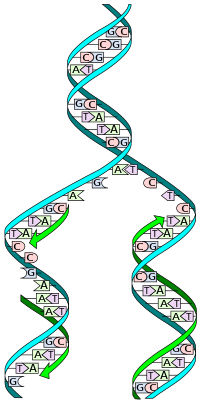
Photo from wikipedia
Diverse molecular choreography of replication Accurate duplication and transmission of genetic information to the next generation requires complex molecular assemblies. Bleichert et al. review replication initiation across the three domains… Click to show full abstract
Diverse molecular choreography of replication Accurate duplication and transmission of genetic information to the next generation requires complex molecular assemblies. Bleichert et al. review replication initiation across the three domains of life, with a focus on origin selection and helicase loading. These processes identify potential origins of replication and prepare them for subsequent bidirectional replication initiation. There are key similarities and multiple differences in replication mechanisms between eukaryotes, prokaryotes, and archaea and many outstanding questions to be answered. Science, this issue p. eaah6317 BACKGROUND Cellular life depends on the ability of organisms to accurately duplicate and transmit genetic information between generations. In bacteria, archaea, and eukaryotes, this process uses sophisticated molecular machineries, termed replisomes, which copy chromosomal DNA through semiconservative replication. At the core of these replication factories reside ring-shaped hexameric helicases that assist polymerases in DNA synthesis by processively unzipping the parental DNA double helix. Replicative helicases are loaded onto DNA by dedicated initiator, loader, and accessory proteins during the initiation of DNA replication in a tightly regulated, multistep process. Although initiators and loaders are phylogenetically related between the bacterial and archaeal/eukaryotic lineages, the molecular choreography of DNA replication initiation turns out to be surprisingly diverse across different systems and employs different strategies to prepare replication origins for subsequent replisome assembly. ADVANCES Early work in bacterial systems established that initiator proteins recognize specific sequence elements (termed replication origins). Nucleotide-dependent oligomerization of the bacterial initiator DnaA at origins facilitates DNA melting and provides an access point for the replicative helicase, DnaB, which is recruited to and loaded onto each of the single-stranded origin regions by interactions with the initiator and other loader proteins to establish bidirectional replication forks. It has recently become clear that the strategies for origin recognition, helicase loading, and duplex DNA melting in archaeal and eukaryal systems, as well as the order of these steps, deviate considerably from the archetypal initiation events followed by bacteria. Although nucleotide-dependent interactions between initiator subunits still control early steps of replication initiation and regulate the association of initiators with origin DNA, they do not appear to contribute to DNA melting. Instead, archaeal/eukaryotic initiators [Orc in archaea or the multisubunit origin recognition complex (ORC) in eukaryotes] and helicase coloading factors cooperate to recruit and load the replicative helicase motor, the minichromosome maintenance (MCM) complex, onto duplex DNA in an inactive, double-hexameric form. Helicase activation, DNA melting, and replisome assembly do not occur until subsequent cell cycle phases, preventing premature replication and exposure of melted, single-stranded DNA regions to DNA damaging factors. OUTLOOK Although the core components of the initiation pathway have been identified, enabling reconstitution of the replication initiation cascade in vitro with recombinant proteins from bacterial and eukaryotic systems, the mechanisms by which these initiation factors function at the molecular level remain ill defined. Moreover, how replication initiation is temporally and spatially linked to the local chromatin environment and coordinated with other cellular (in bacteria and archaea) or nuclear (in eukaryotes) processes is not well understood. Future studies that integrate genetic, biochemical, biophysical, and structural approaches will be pivotal for resolving these questions. Overview of similarities and differences in the initiation of DNA replication across the three domains of life. Bacteria and archaea/eukaryotes share a requirement for an adenosine triphosphate (ATP)–dependent initiator factor that helps catalyze the loading of two ring-shaped, hexameric helicases onto a replication origin, thereby nucleating the formation of a bidirectional replication fork. The bacterial initiator forms a multimeric assembly that actively melts the origin before loading single helicase hexamers, whereas in archaea and eukaryotes, the helicase is loaded as an inactive dodecamer that then isomerizes into two active, single hexamers during or following origin melting. Cellular DNA replication factories depend on ring-shaped hexameric helicases to aid DNA synthesis by processively unzipping the parental DNA helix. Replicative helicases are loaded onto DNA by dedicated initiator, loader, and accessory proteins during the initiation of DNA replication in a tightly regulated, multistep process. We discuss here the molecular choreography of DNA replication initiation across the three domains of life, highlighting similarities and differences in the strategies used to deposit replicative helicases onto DNA and to melt the DNA helix in preparation for replisome assembly. Although initiators and loaders are phylogenetically related, the mechanisms they use for accomplishing similar tasks have diverged considerably and in an unpredictable manner.
Journal Title: Science
Year Published: 2017
Link to full text (if available)
Share on Social Media: Sign Up to like & get
recommendations!